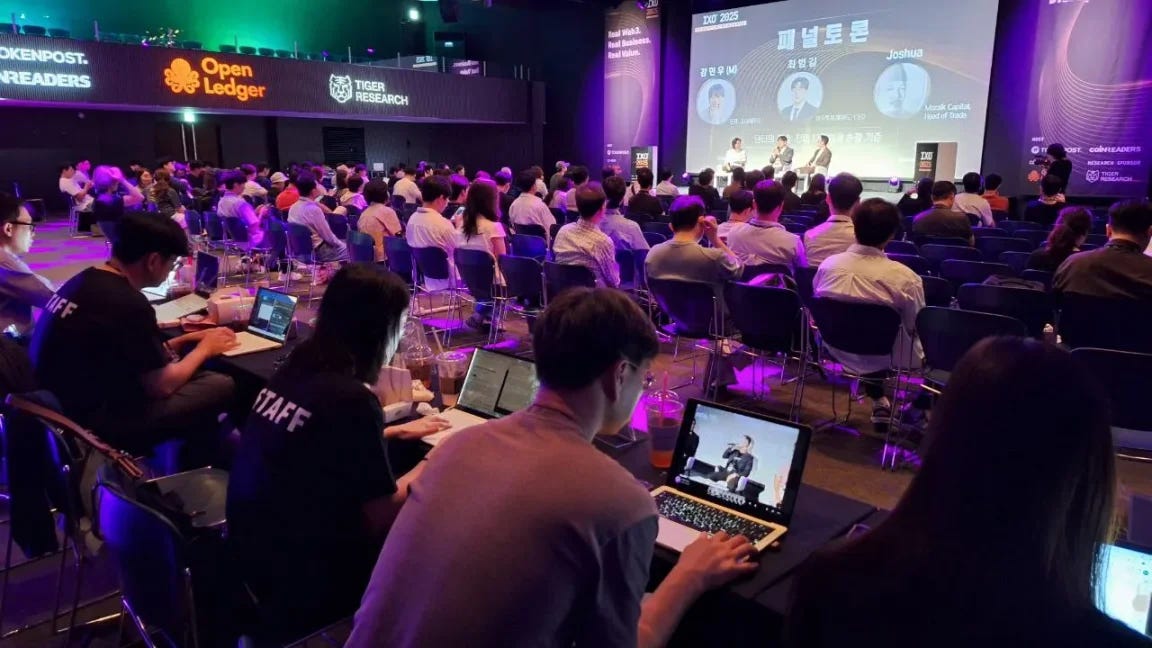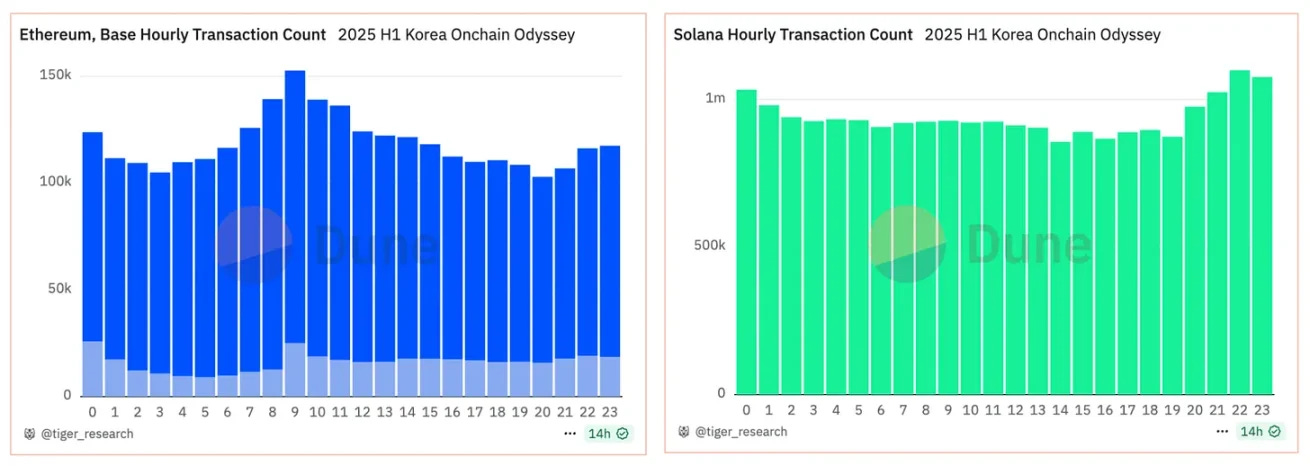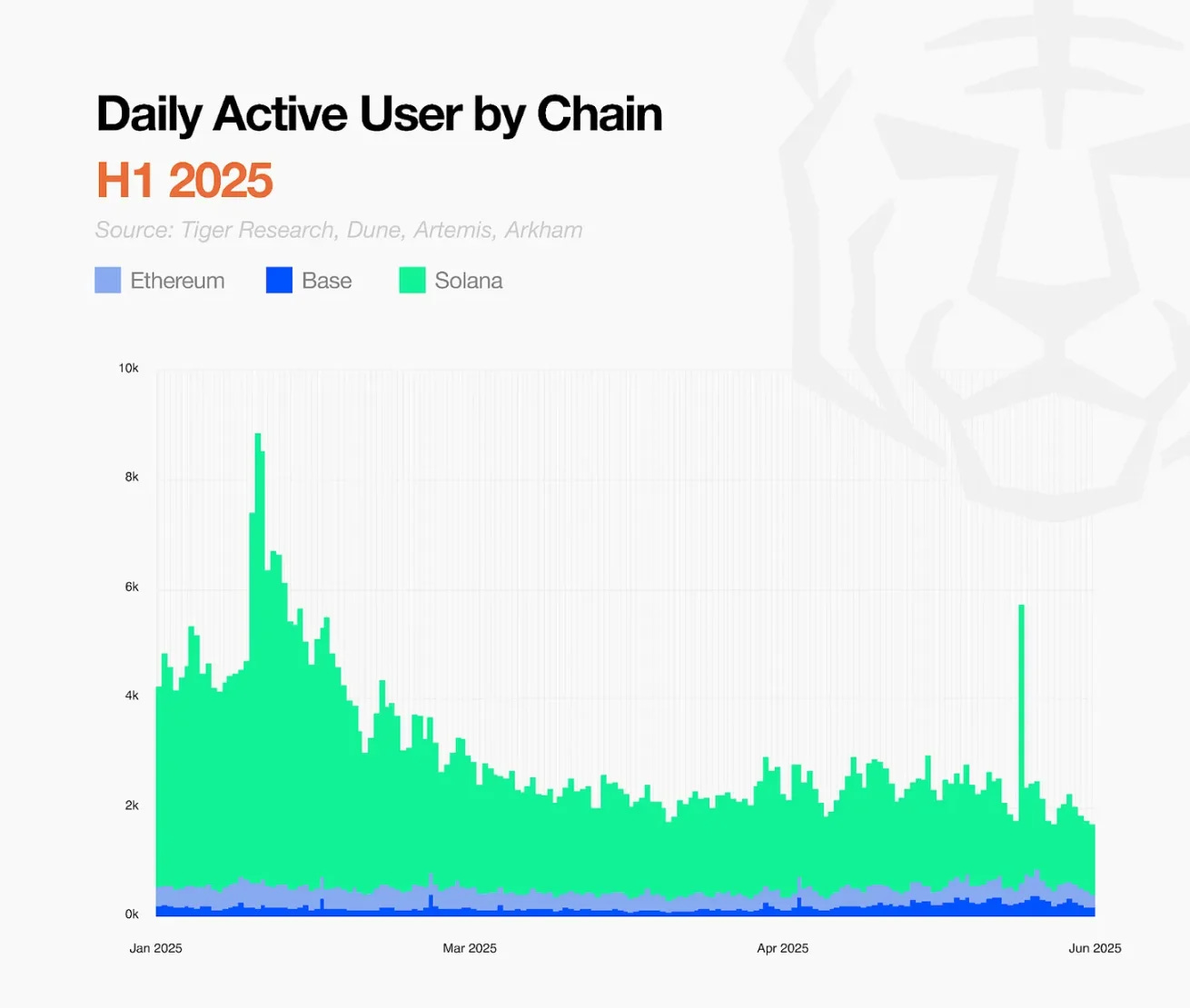After 2025 IXO: In-depth Analysis of On-chain Activities in South Korea
This report is authored by Tiger Research and analyzes the on-chain activities of Korean users in the Ethereum, Base, and Solana ecosystems in the first half of 2025.
Key Summary
In the first half of 2025, the activities of Korean cryptocurrency users expanded from centralized exchanges to on-chain ecosystems. This shift marks the maturation of the market and the diversification of user engagement.
Korean users hold significant amounts of Ethereum assets and maintain stable mainnet participation. Base users gradually increase engagement through decentralized applications (dApps). Solana attracts the most users and has high user activity. However, due to fatigue from short-term events (such as meme coins and meme launch platform battles), Solana experiences a higher user attrition rate.
Korean cryptocurrency users exhibit different behavioral characteristics across various blockchains, making it impossible to summarize them with a single trait. Project teams need to develop effective market strategies through systematic user segmentation and analyze using both qualitative and quantitative methods.
1. Overview of Korean On-Chain User Activities in the First Half of 2025
Korean users have begun to gradually expand their activities from exchanges like Upbit and Bithumb to on-chain engagement, indicating a maturation of the market rather than a temporary phenomenon.
The trading volume on Korean centralized exchanges has always been very high, but on-chain activities are also growing rapidly, leading to a multi-layered market structure in the Korean crypto market, which is no longer centered around exchanges. Recognizing this will help further develop market strategies.

The IXO 2025 event held from January 24 to 25, 2025, further confirmed this market shift. Co-hosted by TokenPost and CoinReaders, TokenPost's CEO Kim Ji-ho stated at the opening ceremony that the number of digital asset investors in Korea has exceeded 10 million, and the cryptocurrency market has surpassed niche technology communities to connect with mainstream audiences.

International participants are trying to gain a deeper understanding of Korean on-chain user engagement, no longer viewing Korea as a market structure centered around exchanges. However, analyzing the characteristics of Korean users remains challenging, and systematically obtaining relevant on-chain data is still a significant challenge.
This report collects on-chain activity data from approximately 80,000 wallets, aimed at readers who need a deeper understanding of the Korean market. The research covers data from the first half of 2025 and examines the behavioral patterns of Korean users in the Ethereum, Base, and Solana ecosystems, providing insights for those considering entering the Korean market.
2. Characteristics of Korean Users: Ethereum, Base, and Solana
2.1. Activity Timing
Ethereum, Base: Activity time (9 AM to 11 PM)
Solana: Early morning hours (midnight to 8 AM)

There are significant differences in participation patterns of Korean users across different blockchains, with notable variations in activity timing. Active user transactions on Ethereum and Base are concentrated during the daily activity hours of 9 AM to 11 PM.
In contrast, Solana's transactions are concentrated in the early morning hours from midnight to 8 AM, with users remaining active late at night, which starkly contrasts with other chains. This is because Solana has formed a transaction-centric ecosystem, with major token issuances and activities aligned with North American time zones. Even in the early morning, when the market is active, Korean users actively participate.
This indicates that Korean users have a high adaptability to the global market, with active investment tendencies that transcend time zone adjustments, showing a reluctance to miss global opportunities. The behavior of Korean users transcends geographical limitations, keeping pace with the rhythm of the global cryptocurrency market.
2.2. Fund Distribution
There are significant differences in fund distribution across different blockchains. According to the collected wallet data, Korean users hold approximately $400 million in total assets on Ethereum, which is about nine times the total assets on Base and Solana. This difference is primarily due to whale wallets rather than the number of wallets. Whales (over $1 million) and mid-tier accounts (over $100,000) account for a large proportion. There are 116 whale wallets on Ethereum, with each wallet averaging $2.5 million.
The asset distribution on Solana shows a different pattern. Retail wallets (under $100) account for 99.9% of all wallets, with an average holding amount of only $30. However, a few whale wallets average over $8 million, creating an extreme polarization in fund distribution.
These data indicate that Korean users exhibit different investment tendencies across different chains. Ethereum attracts conservative large investors who focus on stability, while Solana attracts a large number of retail investors seeking high returns. These retail investors prefer short-term opportunities such as meme coins and meme launch platform tokens. Base attracts medium investors who fall between the two. This indicates that the Korean market has a diverse user base rather than being concentrated on specific investment tendencies.
2.3. User Activity Trends

The trading volume on Ethereum is not affected by market fluctuations or external events, maintaining long-term stability. Korean users in the Ethereum ecosystem focus more on practical activities. They are more involved in actual dApp usage, asset custody, and governance activities rather than DeFi-centered trading activities.
In contrast to Ethereum, Base and Solana's transactions are sensitive to the overall sentiment of the cryptocurrency market and short-term events. When cryptocurrency prices surged at the beginning of the year, trading volumes spiked; this was followed by a brief decline, and trading volumes rose again in May when Bitcoin broke $100,000.

The trading trends of Base and Solana are similar, but there are differences in daily active user numbers. Solana experiences a higher user attrition rate due to meme coin launch platforms and short-term event structures. Thanks to the adoption of diverse dApps and consumer services, although Base has fewer loyal users, the number of active users is steadily increasing.
2.4. dApp Usage

The dApp usage of Korean users on different chains further reveals their differences.
On Solana, activities are transaction-centric. Korean users primarily focus on DeFi trading, with a lower usage rate of stablecoins, and SOL trading pairs dominate.
On Ethereum and Base, users are more actively involved in remittance and deposit activities, using USDT or USDC for transactions. There are diverse practical use cases on these chains. The Kaito InfoFi service on Base is one of the main drivers attracting users, currently ranking third on Base. Korean users respond positively to reward structures and tend to seek returns through token staking and incentive claims.
3. Conclusion
This report analyzes the on-chain activities of approximately 80,000 Korean cryptocurrency users, which aids in developing more effective market entry strategies.
Most importantly, Korean users cannot be viewed as a homogeneous group. Compared to other markets, Korean users have a deeper engagement with the cryptocurrency market. The characteristics of Korean users are primarily reflected in the following three aspects:
First, Korean users demonstrate strong adaptability to the global market. The early morning activities on Solana indicate that their participation transcends time zones, with users unwilling to miss opportunities in the global crypto market, exhibiting behavior that is not geographically constrained and keeping pace with the rhythm of the global cryptocurrency ecosystem.
Second, there is a clear differentiation in strategies and investment tendencies across different chains. The same group of Korean users acts as conservative investors focused on stability on Ethereum; on Solana, they become speculative investors seeking high returns; and on Base, they exhibit moderate tendencies. This strategic differentiation forms a hierarchy based on investment objectives and risk preferences. Users optimize their participation strategies according to the characteristics and culture of each ecosystem, indicating that Korean users are a complex group.
Third, users show a high interest in incentive-based services. They actively participate in these services, with the rapid rise of Kaito on Base being a prime example. Korean users engage in yield activities through token staking and reward systems. On-chain data confirms this trend, with Kaito listing Korean users separately on the leaderboard, and some projects expanding their reward pools specifically for Korean users, validating this observation.
Global projects considering entering the Korean market need to develop customized strategies that align with user characteristics. Korea is a balanced market, with no bias towards specific stages or types.
Strategy development should prioritize blockchains that suit the layered expectations and behaviors of target users. There are significant differences in the expectations and behaviors of Korean users across different chains.
On the operational level, providing services based on North American time zones will not pose significant issues, and a global operational system can be incorporated into long-term expansion plans.
User acquisition and retention require clear and sustainable incentive structures. Korean users are highly sensitive to token staking and reward systems, responding more positively to long-term participation structures, while short-term activities yield poorer results.
Most importantly, these users should be viewed as partners in the development of the ecosystem rather than mere users. This report aims to provide practical assistance for the development of relevant strategies.









